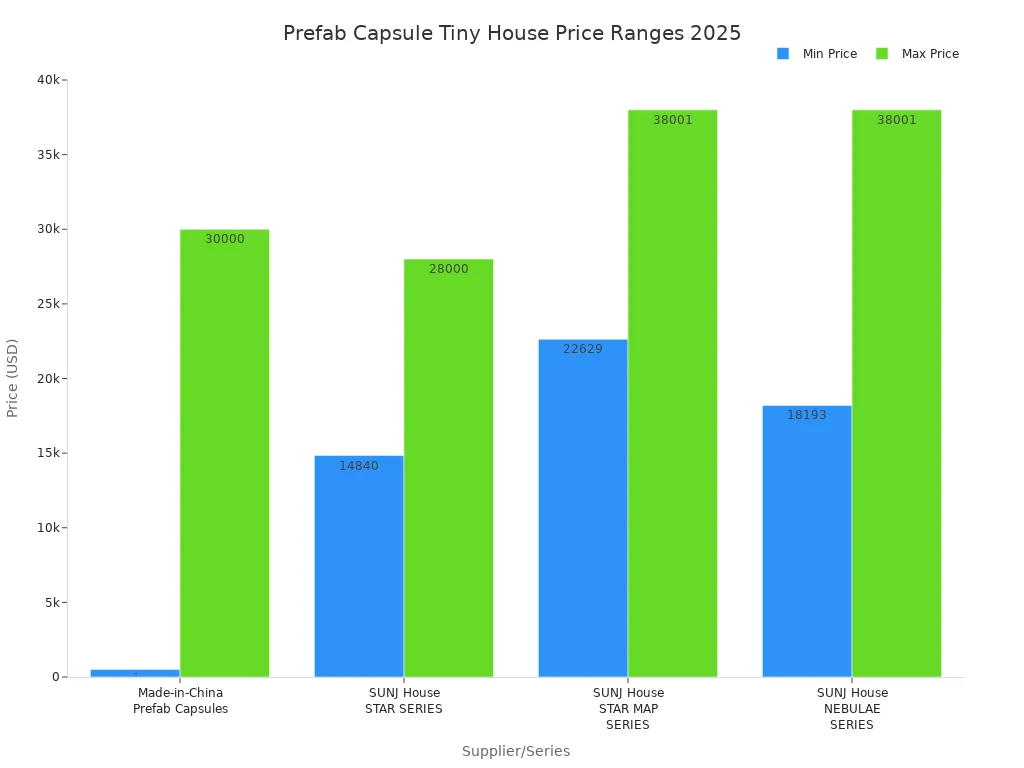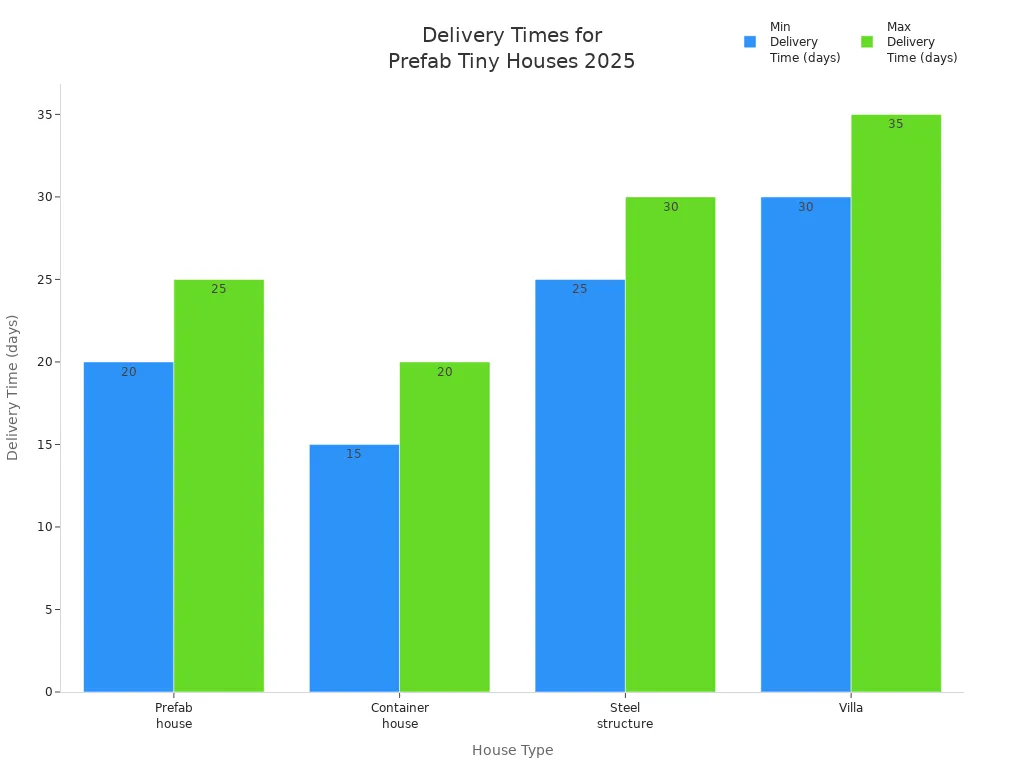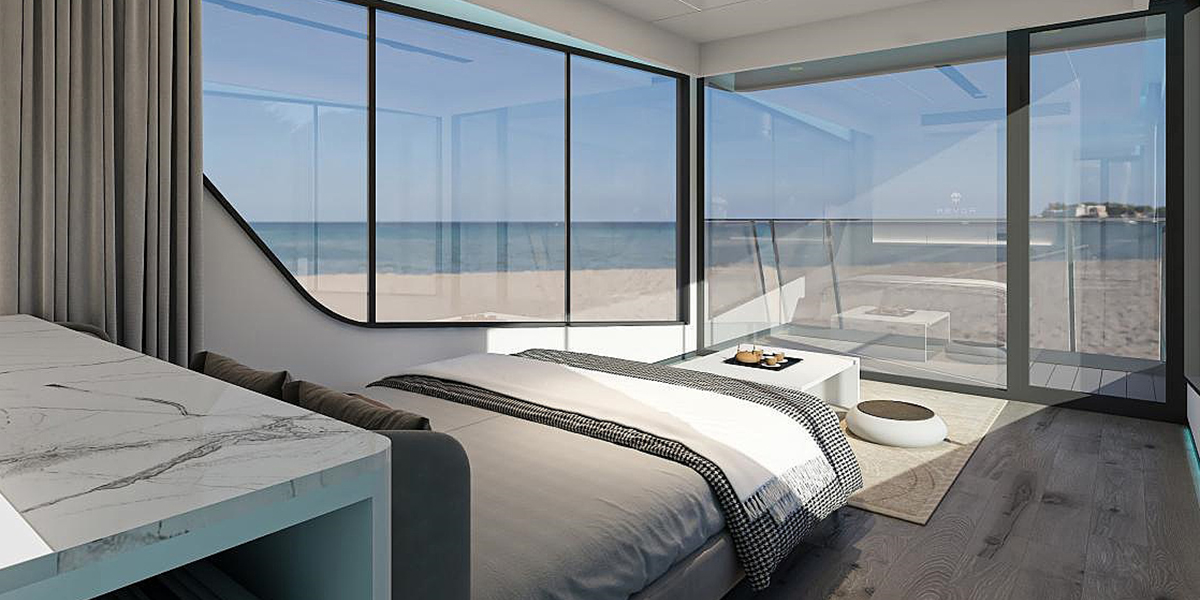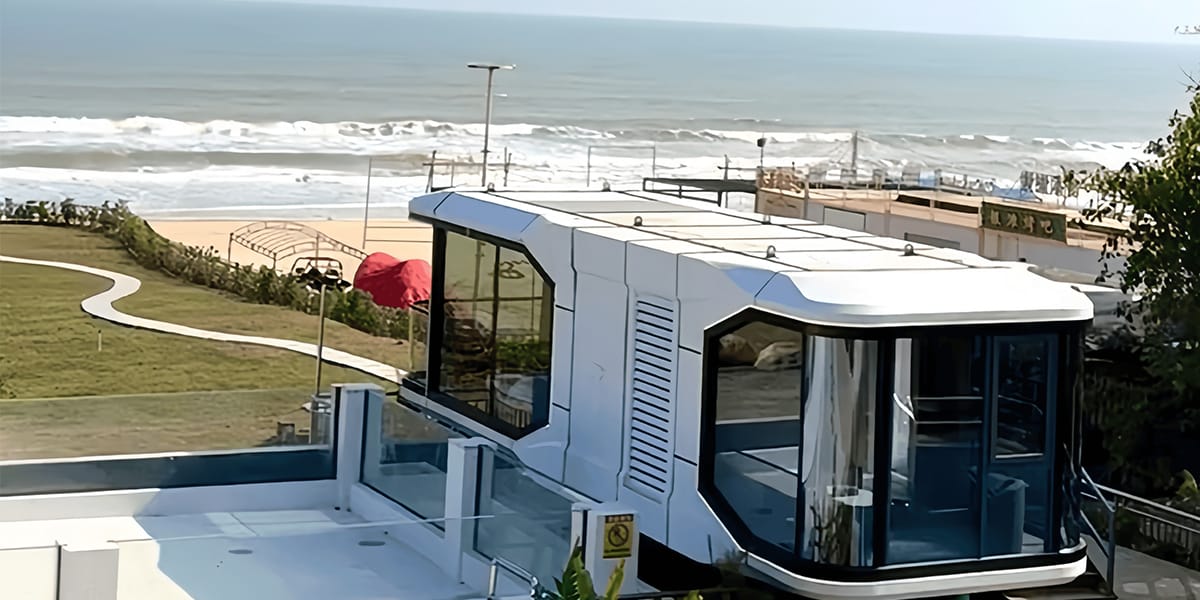
24 Jul How to Buy a Prefab Capsule Tiny House for Tourism or Leisure in 2025
Table of Contents
Ready to buy a capsule tiny house for your next adventure or getaway? First, decide what you want from your capsule tiny house. Check out different prefab manufacturers and see what fits your style. Compare prices, features, and make sure the prefab tiny house meets your needs. Ask questions and look at reviews. Stay confident and take each step with care so you get the best experience.
Key Takeaways
Capsule tiny houses are smart and cozy. They are good for travel or fun. They save space and are easy to move.
Pick your tiny house by thinking about how you will use it. Think about the size, layout, and where you want it. Check local rules so you do not have problems.
Look at different makers and models online. Find the best price, features, and quality for your money and needs.
Choose strong materials and good insulation. Make sure it has modern things for comfort and energy savings. This helps it last longer.
Follow easy steps to buy: do research, get prices, sign papers, get your site ready, and plan delivery. This makes everything go well.
Why Choose a Capsule Tiny House
Benefits for Tourism
If you want a new way to travel, try a capsule tiny house. These homes fit a lot into a small area. You get comfort and style in a smart design. Travelers like how every space is used well. You can pull out a bed or hide a table. This makes your stay feel cozy, not crowded.
Here’s a quick look at how a capsule tiny house compares to regular vacation places:
Feature | Capsule Tiny Houses | Traditional Vacation Accommodations |
|---|---|---|
Space Efficiency | Built for minimalism with furniture that folds and saves space. | Bigger rooms but space is often wasted. |
Cost Effectiveness | Cheaper to build and keep up because they are made in factories and are small. | Costs more to buy and take care of. |
Portability | Easy to move and set up, so you can travel or change locations. | Stays in one place, moving is hard and expensive. |
Choosing a capsule tiny house is good for the earth. These homes use green materials and smart energy like solar panels. You use less power and water, which helps the planet. Many people who like tiny houses want to travel light and not harm nature. You can join them and have a fun, modern stay.
Capsule tiny houses also look cool and new. Their style makes your trip feel special. You get a bed, bathroom, and kitchen, all in a small space. These homes are strong, simple to set up, and easy to care for. You can put a few on a small piece of land. This is great if you want to start a tiny house hotel or rent them out.
Common Uses
There are many ways to use a capsule tiny house. Here are some favorites:
Stay in a capsule hotel in the city for a cheap, modern trip.
Book a tiny house in nature for a quiet getaway.
Try a capsule pod at a campground for a warm, safe place.
Use a tiny home as a guest house or office in your yard.
Rent out a tiny house or use it for a tiny house hotel.
No matter how you use it, a tiny house gives you freedom. You can move it, set it up fast, and enjoy new places anytime.
Prefab Tiny House Buying Factors
 Intended Use
Intended Use
Start by thinking about how you want to use your tiny house. Do you plan to rent it out to travelers, use it as a weekend getaway, or set up a small hotel? Some people choose a tiny home for camping, while others want a modern pod for city stays. If you want to host families, you might need more space and extra beds. For solo travelers, a compact capsule with just the basics works well. Your intended use shapes every other choice you make.
Size and Layout
Tiny houses come in many sizes and layouts. You can pick a simple pod or a larger model with more rooms. Here’s a quick look at popular options:
Model | Size (L x W x H) | Area (sqm) | Frame Material | Layout/Features |
|---|---|---|---|---|
11.5 x 3.3 x 3.2 m | 38 | Galvanized steel | Bedroom, bathroom, living room | |
600 x 240 x 240 cm | ~14.4 | Galvanized steel | Compact, customizable |
Some tiny homes have stacked layouts for more guests. Others use dorm-style pods with shared bathrooms. You can find a layout that fits your needs.
Location and Mobility
Where you put your tiny house matters. Do you want to move your home from place to place? Many tiny homes are portable, so you can set them up in the mountains, by a lake, or even in a city. These homes are easy to move and quick to install. You can enjoy a new view whenever you want. Some models even have smart controls and eco-friendly features for outdoor spots.
Aspect | Explanation | Example/Application |
|---|---|---|
Move your tiny home to different locations easily. | Take your home to a remote campsite or a city lot. | |
Rapid Assembly and Installation | Set up your tiny house in just one day. | Save time and money on labor. |
Diversified Functional Layouts | Pick a layout that fits your lifestyle, from solo pods to family units. | Choose bedrooms, kitchens, or open spaces. |
Environmental Protection and Sustainability | Use green materials and solar power for a low-impact stay. | Enjoy comfort while caring for the planet. |
Regulations
Before you buy, check the rules in your area. Zoning laws may limit where you can place your tiny house. Many places only allow these homes in rural or suburban zones. You might see size limits, like a maximum of 400 square feet. You also need to follow safety rules for plumbing, electricity, and gas. Always get the right permits and have licensed pros handle the setup. Final inspections make sure your home is safe and legal.
Tip: Always talk to local officials before you buy or move your tiny house. This helps you avoid delays and extra costs.
Budget
Your budget shapes your choices. Tiny homes range from $500 for basic models to $38,000 for luxury units. Most people spend between $2,500 and $30,000 for a finished, ready-to-use tiny house. Prices depend on size, features, and how much you want to customize.
Supplier/Series | Model Examples | Size (sqm) | Price Range (USD) | Notes |
|---|---|---|---|---|
Made-in-China Prefab Capsules | Various models | N/A | $500 – $30,000 | Basic to fully finished units |
E30, E50, E70, D50 | 8 – 25 | $14,840 – $28,000 | Airbnb and commercial uses | |
SUNJ House – STAR MAP SERIES | M50, M70 | 28 – 38 | $22,629 – $38,001 | Upscale hotels, glamping |

Think about what matters most to you. Do you want a simple pod or a high-end tiny home with all the extras? Set your budget before you shop, so you can focus on the best options for your needs.
Where to Find Prefab Tiny Homes
Manufacturers
There are many prefab capsule tiny house makers to pick from. Some companies are known for good quality and smart designs. They also help customers well. Here is a table to compare some top makers:
Manufacturer / Distributor | Model / Product Name | Highlights | Price Range (USD) | Notes |
|---|---|---|---|---|
S.E.Q (RiaKhan LLC) | S.E.Q Prefab Solar Powered Mobile Pod | Solar power, smart door, thick insulation, sunroof, customizable | From $56,999 | US distribution, top-rated |
Nomadnest | Modern Mobile Tiny Home | Weather-resistant, towable, modern kitchen and bath | From $45,800 | Modern design, durable |
AMGUI | Two-Storey Tiny House | Customizable, stable, built-in storage, LED lights | From $29,999 | Pro installation available |
TheSmartSpace Official | Prefab Tiny House with Porch | Expandable, weatherproof, family-sized, steel frame | From $23,650 | Sold on Amazon |
Generic Modular Producers | Modular Prefab House-on-Wheels | Durable, mobile, steel roof and walls | From $52,500 | Noted for mobility |
These makers have prefab homes at different prices. Many have several models, so you can choose what you like.
Online Marketplaces
It is easier to find prefab tiny homes online. Big websites like Amazon have sellers such as TheSmartSpace Official. Some companies, like Glam Tiny House, have big factories and ship many homes each month. They give long warranties and help with setup. You can also look at Studio Shed, Wheelhaus, and Mint Tiny Homes. Each site has special features, like off-grid choices or green materials. You can compare homes, read reviews, and sometimes buy with a few clicks.
Tip: Always look at the minimum order amount. Some sellers want you to buy more than one home, mostly for business buyers.
Price Range
Prefab capsule tiny houses have many price choices. Some start at about $9,500. The most expensive ones can cost $151,700 or more. The price changes with size, design, and materials. If you want to change a lot, it costs more. Cheaper prefab homes are finished faster but have fewer choices. Tiny homes often cost more for each square foot than normal houses. This is because they have special systems in a small space. If you want a simple home, you can save money. If you want a fancy home, you will pay more.
Capsule Tiny House Features
Durability
You want your tiny house to last a long time. Builders use strong materials and smart ways to build. This helps your home handle bad weather, moving, and daily life. Look at this table to see what makes a capsule tiny house strong:
Material | Role in Durability and Construction Method |
|---|---|
Aviation-grade aluminum veneer | Protects the outside, keeps the house steady, and blocks rain and sun. |
Steel | Forms the main frame, gives strength, and absorbs shocks. |
Insulated panels | Used on walls and roofs for warmth, fire safety, and to keep water out. |
Polyurethane foam | Helps keep the inside comfy by holding in heat or cool air. |
Flourocarbon paint | Covers the outside and keeps the house looking new. |
Hot-dip galvanized plates | Makes the frame stronger and helps with bumps when moving. |
Manufacturers test each tiny house and follow strict rules. Skilled engineers help make sure your home is safe and strong. You get a place that is sturdy and reliable.
Insulation
You want your tiny house to feel warm in winter and cool in summer. Prefab capsule homes use good insulation and tight seams. This keeps heat inside when it’s cold and outside when it’s hot. Many models have special windows and double insulation. This helps you save money on heating and cooling. The materials, like wood, steel, and aluminum, also block noise and water.
Tip: Good insulation keeps your tiny house comfy and saves energy.
Amenities
Modern capsule tiny houses fit a lot into a small space. You can get:
Kitchens with smart storage
Bathrooms with smart toilets and glass doors
Air conditioning and heating
Big windows and skylights for sunlight
Smart home features like voice control and lights
Here’s a table of what you might find:
Amenity Category | Features Included |
|---|---|
Interior Design | Bamboo charcoal walls, waterproof floors, big windows, skylight |
Climate Control | Central AC, water heater, bathroom heater |
Bathroom Amenities | Multi-functional bath, smart toilet, glass sliding door |
Smart Home Features | Voice control, adjustable lights, smart control system |
Optional Extras | Electric floor heating, projector, star ceiling |
You get a tiny house that is ready to live in and feels modern.
Customization
You can change your tiny house to fit your style and needs. Many companies let you pick smart home systems or different layouts. Want floor heating or a projector? You can add those. Pick your favorite colors, materials, and lights. These upgrades can cost more and may take a few more days. But you get a home that is just right for you.
Customization Options | Price Impact | Delivery Time Impact |
|---|---|---|
Raises price | About 30 days | |
Electric floor heating | Increases cost | Delivery time stays about 30 days |
Price goes up with more features | Delivery time may vary slightly |
Eco-Friendly
Capsule tiny houses help you live in a green way. Builders use recycled steel, bamboo, and old wood. Solar panels and smart thermostats help save energy. Good insulation keeps your house warm or cool without wasting power. These features can cut your energy use by up to 65%. You help the earth and enjoy a modern home.
Delivery
You do not have to wait long for your tiny house. Most suppliers deliver in 15 to 30 days, depending on what you choose. They ship your house in a big container, ready to set up fast. Some companies help with installation, so you can use your new space soon. Shipping costs depend on where you live and the size of your house.

Note: Ask about payment protection or trade assurance for extra safety when your house is delivered.
Prefab Buying Process
Buying a prefab capsule tiny house can feel like a big project, but you can break it down into simple steps. Here’s how you can go from dreaming about your tiny house to relaxing inside it.
Research and Compare
Start by looking at different options. You want to find the best fit for your needs and budget. Here’s a step-by-step way to compare your choices:
Search online for different manufacturers and see what styles and prices they offer.
Look for layouts that include the basics you need, like a kitchen, bathroom, and bedroom.
Think about extra costs, such as buying land, getting permits, and hooking up utilities.
Check local rules to make sure you can put your tiny house where you want.
Learn about ways to pay, like loans or special financing.
Ask about warranties and what kind of care your house will need.
Decide what size, materials, and features matter most to you.
Find out how the house will get delivered or if you need to pick it up.
Tip: Make a checklist of your must-haves before you start shopping. This helps you stay focused and avoid surprises.
Get a Quote
Once you find a few houses you like, you need to get a price quote. Companies will ask you for details so they can give you an accurate number. Here’s what you should prepare:
Tell them your size and layout preferences, like how many rooms you want.
Share what materials you prefer, such as eco-friendly finishes.
List any custom features, like solar panels or smart home tech.
Ask about delivery and installation costs.
Make sure your site is ready, with water, sewer, and electricity connections.
Check if you need permits or special approvals.
Ask about payment terms. Most companies want a 50% down payment.
Find out how long it will take to build your house. Most take 4-6 weeks.
Note: You may need to arrange for a truck and crane to move and set up your house. Make sure your site is easy to reach.
Contract and Deposit
After you agree on the price and details, you’ll sign a contract. This protects both you and the seller. Here’s what you can expect:
Contract Term | Details |
|---|---|
Deposit Requirement | |
Balance Payment | Remaining balance before loading |
Minimum Order Qty | 1 unit |
Warranty | 12 months |
Production Time | 10 to 60 days depending on order |
Read the contract carefully. Ask questions if anything is unclear. Keep a copy for your records.
Production and Shipping
Once you pay the deposit, the company starts building your house. They use strong materials and follow your choices for layout and features. Production usually takes between 10 and 60 days, depending on how much you customize.
When your house is ready, the company will pack it carefully, often with waterproof wrapping. They arrange shipping, and you’ll get updates on when to expect delivery. You may need to pay for shipping, so ask about costs upfront.
Tip: Double-check that your site is ready before your house arrives. This includes permits, a solid foundation, and clear access for trucks and cranes.
Delivery and Setup
Delivery day is exciting! Here’s what happens next:
The company delivers your prefab capsule tiny house to your site.
Workers use a crane to lift the house into place.
The modular design makes setup quick—sometimes just 15 minutes for one unit.
The team connects utilities like water and electricity.
You check everything to make sure it works and matches your order.
Your new house is now ready for you to enjoy. The whole process, from research to move-in, can be smooth if you plan ahead and ask the right questions.
Remember: Always check local rules and get the right permits before you start. This helps you avoid delays and extra costs.
Tiny House Cost and Financing
 Price Breakdown
Price Breakdown
When you check the price of a prefab capsule tiny house, you pay for more than just the house. The total cost has different parts. Here is a simple table to show what you pay for:
Price Component | Details |
|---|---|
Base Price | $39,000 to $59,000 for small models; up to $99,000 for bigger homes (up to 400 sq ft). |
Shipping to Nearest Port | This is usually part of the base price. |
Delivery from Port to Site | Not included; you need to hire a truck for big loads. |
Crane Services | Not included; you need a crane to move your home. |
Permits and Utilities | Not included; you must get permits, prepare the site, and connect utilities. |
Site Preparation | You need flat, strong ground and utility hookups before setup. |
Installation | Local workers set up your home and connect everything. |
Tip: The base price pays for the house and shipping to the port, but you pay extra for delivery, crane, permits, and setup.
What Affects Cost
Many things can change how much your tiny house costs. Here are the main things to think about:
Size and layout: Bigger or more detailed homes cost more.
Building materials: Steel frames last longer but cost more than wood.
Configuration: Adding a bathroom, air conditioning, or smart tech makes it pricier.
Customization: Special shapes or fancy finishes cost extra.
Transportation and installation: Shipping and crane costs depend on distance and your site.
Hidden costs: Permits, legal fees, and land work can surprise you.
Long-term costs: Upkeep and utility hookups cost money over time.
If you want to save money, pick a standard model with basic features. Custom homes and fancy extras make your tiny house cost more.
Financing Options
You have a few ways to pay for your new home. Here are some choices to think about:
Specialized lenders know about prefab homes and may give better deals.
Some people use a regular mortgage if the tiny house is on a permanent base.
FHA and VA loans help some buyers with lower rates and flexible rules.
Personal loans or home equity loans work for some, especially if you want a fast, cheaper way.
Note: Always talk to your lender to see what works best for your budget and plans.
Tips for Buying Prefab Tiny Houses
Avoiding Pitfalls
Buying a prefab home can feel exciting, but you need to watch out for common mistakes. Here are some things to avoid:
Skipping local zoning laws. Some places have rules about what you can build and where. These rules cover the size, height, and how close your home can be to the road or other buildings.
Ignoring building codes. Every area has safety rules for things like fire, electricity, and plumbing. If your home does not meet these codes, you could face big problems.
Not checking with local officials. Always talk to your city or county planning office before you buy. They can tell you if your plans are allowed.
Forgetting about permits. You may need special papers before you set up your home. Missing these can cause delays or even legal trouble.
Assuming all areas are the same. Some places make it easy to set up a prefab home, but others do not. Rules can change from one town to the next.
Tip: Take time to learn the rules in your area. This helps you avoid costly mistakes and keeps your project on track.
Quality and Warranty
You want your new home to last and stay safe. Many companies offer strong warranties and quality checks. For example, some makers use aviation aluminum for the shell and promise it will last up to 30 years. If you have a problem, they fix it fast—sometimes in just a week. Other companies give a one-year warranty on most parts, but not on glass or appliances. They also check every home before shipping and give you a report to show it passed. Some even help with shipping and offer support after you move in.
Note: Always ask about what the warranty covers and what it does not. Make sure you know who to call if something goes wrong.
Maximizing Value
You want to get the most for your money. Here are some ways to boost value:
Compare different makers and models. Look for homes with good materials and smart designs.
Choose features that matter most to you, like energy-saving windows or solar panels.
Ask about third-party inspections. These checks help make sure your home is built right.
Pick a company that offers good customer support. This can save you time and stress later.
Plan for the future. Think about how you might use your tiny house in new ways, like renting it out or moving it to a new spot.
A little research now can help you enjoy your home for years to come.
You now know how to buy a capsule tiny house for travel, fun, or even a rental business. Start by thinking about what you want. Check out trusted sellers and make sure you follow local rules. Take your time and ask questions. Owning one gives you freedom to explore, relax, or earn extra income. Ready to begin your search? Your next adventure could be just a few clicks away!
FAQ
How long does it take to get a prefab capsule tiny house delivered?
Most companies bring your tiny house in about 15 to 30 days after you pay the deposit. If you want special features, it might take a few more days. Always ask the seller how long delivery will take.
Can you live in a capsule tiny house year-round?
Yes, you can live in one all year. Good insulation and heating keep you comfortable in any season. Make sure your model has what you need for your weather.
Do you need special permits for a prefab tiny house?
You often need permits for setup, utilities, and sometimes for the house itself. Always talk to your local officials before you buy. Rules are different in each place.
What utilities do capsule tiny houses need?
You need water, electricity, and sometimes sewer hookups. Some models use solar panels or composting toilets. Ask your seller what is included and what you need to add.
Can you customize the inside of your tiny house?
Yes! Many companies let you pick colors, layouts, and smart features. You can add things like floor heating or a projector. Custom choices may cost more and take extra time.




 Intended Use
Intended Use Price Breakdown
Price Breakdown